Mastering the Art of Vanilla Cake Baking
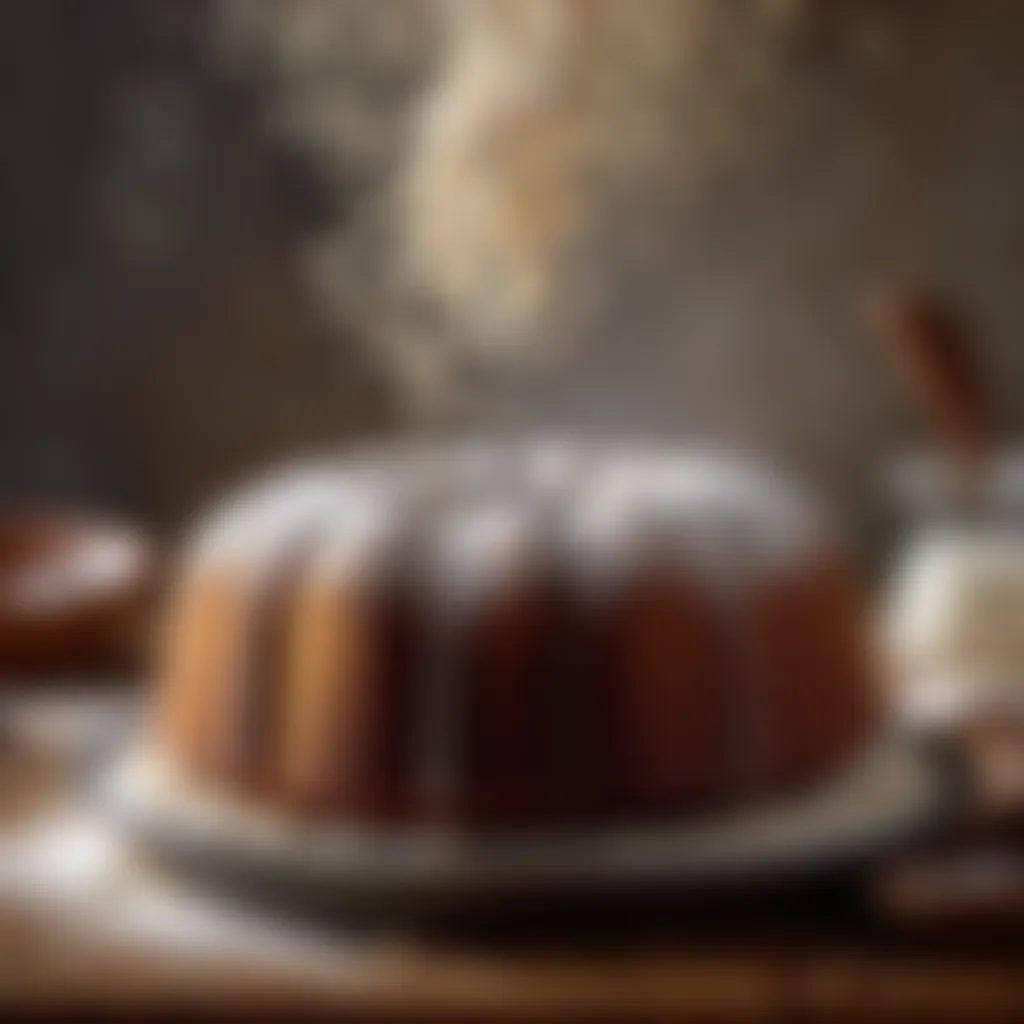
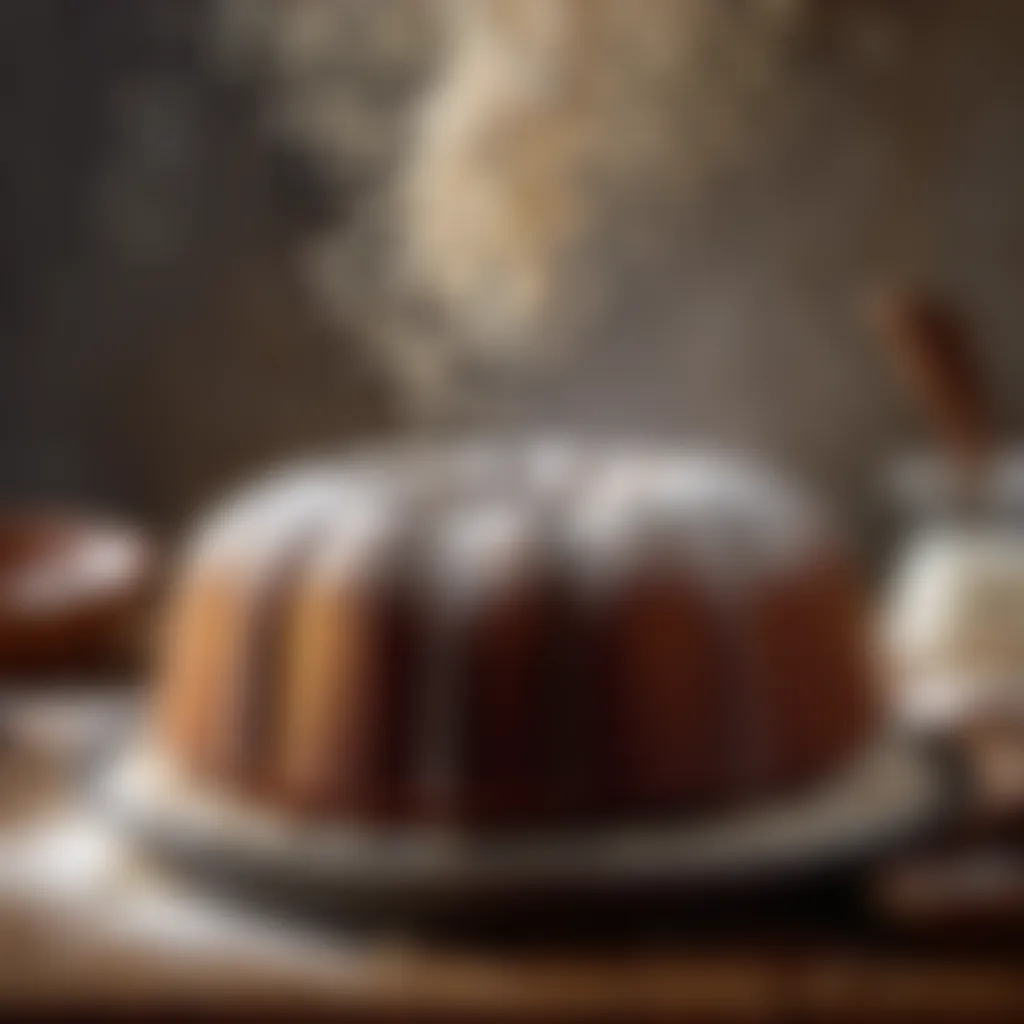
Intro
Baking a vanilla cake sounds simple enough, but the process has its little nuances that can either make or break your end result. This isn't just about mixing ingredients together willy-nilly and hoping for the best. It takes a bit of finesse, a dash of understanding, and the right ingredients to get that truly perfect cake that leaves everyone coming back for another slice. When you think about what makes a cake memorable, it often boils down to texture, flavor, and the way you present it.
In this guide, we’ll explore the meticulous steps necessary to achieve a vanilla cake that is moist and bursting with flavor. From gathering the right ingredients to mastering the techniques that elevate an ordinary cake into something extraordinary, you will find every aspect thoroughly covered. If baking is your passion, or you’re just stepping into this delightful world, you’re about to embark on a journey that promises rich tastes and satisfying results.
Before diving into the crystalline world of mixing and baking, it's crucial to ensure you have everything you need right at your fingertips. This ensures a smooth process that from start to finish feels more like a joy than a chore.
Foreword to Vanilla Cake
Vanilla cake, a classic and beloved dessert, serves as a canvas for culinary creativity. In this article, we set the stage to explore not just the essence of vanilla cake, but also its historical relevance and culinary roots. Understanding this cake means appreciating the simplicity yet profound flavors that resonate with many.
Historical Context of Vanilla Cake
The roots of vanilla cake can be traced back centuries, woven into the fabric of many cultures. The journey begins in the 18th century, when vanilla, derived from the orchids of the genus Vanilla, found its way from the Mexican jungles to European palates. Initially a rare and expensive ingredient, it was often used by the elite.
The vanilla cake as we know it has evolved with the changing taste buds and resource availability. By the 19th century, baking became more accessible with the invention of baking powder. This democratization of flour and sugar opened up kitchens everywhere to create moist and fluffy vanilla cakes, transforming them from a rare treat to a staple at celebrations.
Fun Fact:
"In the late 1800s, vanilla cake became a popular choice for wedding cakes, symbolizing purity and cleanliness."
As cultures clashed and merged, especially in America, vanilla cake saw numerous adaptations. Each region added its own flair, making it even more versatile. The humble vanilla cake now has a rich tapestry of flavors—each bite telling a story of its journey through time.
Culinary Significance
In the realm of baking, the vanilla cake stands as a benchmark. It's not just about sweet flavor; it represents the understanding of technique and ingredient synergy. For many, this cake is a doorway to baking, where novice bakers often start their sweet journey.
The beauty of vanilla cake lies in its versatility. It acts as a base that begs for variation—whether it's a hint of chocolate, a splash of citrus, or a spattering of fresh berries. Its adaptability to flavors not only showcases the skill of the baker but also invites creativity in the kitchen. This makes it an ideal choice for occasions ranging from birthdays to anniversaries.
In today's culinary landscape, the vanilla cake has retained its charm while also anchoring itself in contemporary trends. From being dressed up with ganaches to being layered with fruity fillings, this cake continues to delight. Understanding its culinary significance helps bakers appreciate why mastering the vanilla cake can elevate their baking skills.
By commencing our exploration of the perfect vanilla cake, we anchor ourselves in its rich history and appreciate its ongoing relevance in kitchens around the world. This foundation sets the stage for deeper exploration into the essential ingredients that transform a basic recipe into an extraordinary dessert.
Essential Ingredients
When it comes to baking the perfect vanilla cake, the ingredients play a pivotal role. Each element brings its own characteristics to the cake, influencing not just flavor but texture and appearance as well. The quality and choice of ingredients can make or break your baked masterpiece. To achieve a fine balance that showcases the classic vanilla flavor, let’s unwrap the intricacies of these essential ingredients.
Quality of Vanilla
Vanilla is the star player in this dessert. The right type of vanilla can elevate your cake from simply delicious to utterly heavenly. There are typically two forms you might consider: vanilla extract and vanilla bean. The extract, particularly if it’s made from pure vanilla beans, offers a rich flavor and aromatic qualities that can transform your batter.
Using vanilla bean specks can create a visual allure that many find appealing. When baking, quality over quantity should guide your choices. Opting for high-quality, pure vanilla may require a bit more investment, but the payoff in flavor is undeniable. It's like adding the perfect final touch to a painting—subtle yet profound.
"A good vanilla extract is like a love letter, best when it’s genuine and heartfelt."
Choosing Flour Types
Flour seems straightforward, but the type you select can dramatically change the cake’s structure. All-purpose flour is often the go-to, but cake flour has a lower protein level that helps create a lighter, airier texture. If you want your vanilla cake to be soft and delicate, cake flour is your best bet. However, if all you have is all-purpose, don’t sweat it too much; it can still yield a good cake.
Considerations in Flour Choices:
- Cake Flour: Ideal for a light texture. Look for a brand that’s finely milled.
- All-Purpose Flour: More versatile, good for those who bake various recipes.
- Whole Wheat Flour: Can add health benefits, but be aware it may alter texture and flavor.
Role of Sugar
Sugar isn’t just about sweetness—it's a key player that affects your cake’s overall texture and moisture content. It’s involved in the creaming process, which adds air into the batter, creating a light and fluffy cake. Different types of sugar can enhance your cake's character. Granulated sugar is standard, but using brown sugar can impart a slight caramel flavor and moisture.
In baking, the ratio and type of sugar can dictate whether your cake will have a delightful crust or a dense, soggy bottom. Keep in mind that the sugar also contributes to browning; a well-caramelized exterior is often the hallmark of a well-baked cake.
Importance of Eggs
Eggs serve multiple purposes in baking—binding, leavening, and enriching. The proteins in eggs contribute to the cake’s structure, while the yolks provide richness and color. It's usually best to use room temperature eggs as they mix more easily, helping to integrate air into the batter.
Tips for Eggs in Baking:
- Always use fresh eggs for best results.
- If a recipe calls for large eggs, avoid sizing down unless absolutely necessary, as this can affect the final product.
Baking Powder vs Baking Soda
Understanding the difference between baking powder and baking soda can help ensure your cake rises perfectly. Baking soda is a base that needs an acid to activate it, like buttermilk or vinegar. On the other hand, baking powder already contains an acid, making it a little simpler to use. For vanilla cake, check the recipe to see which leavening agent it calls for. Both have their separate roles but the catch is in their effective application.
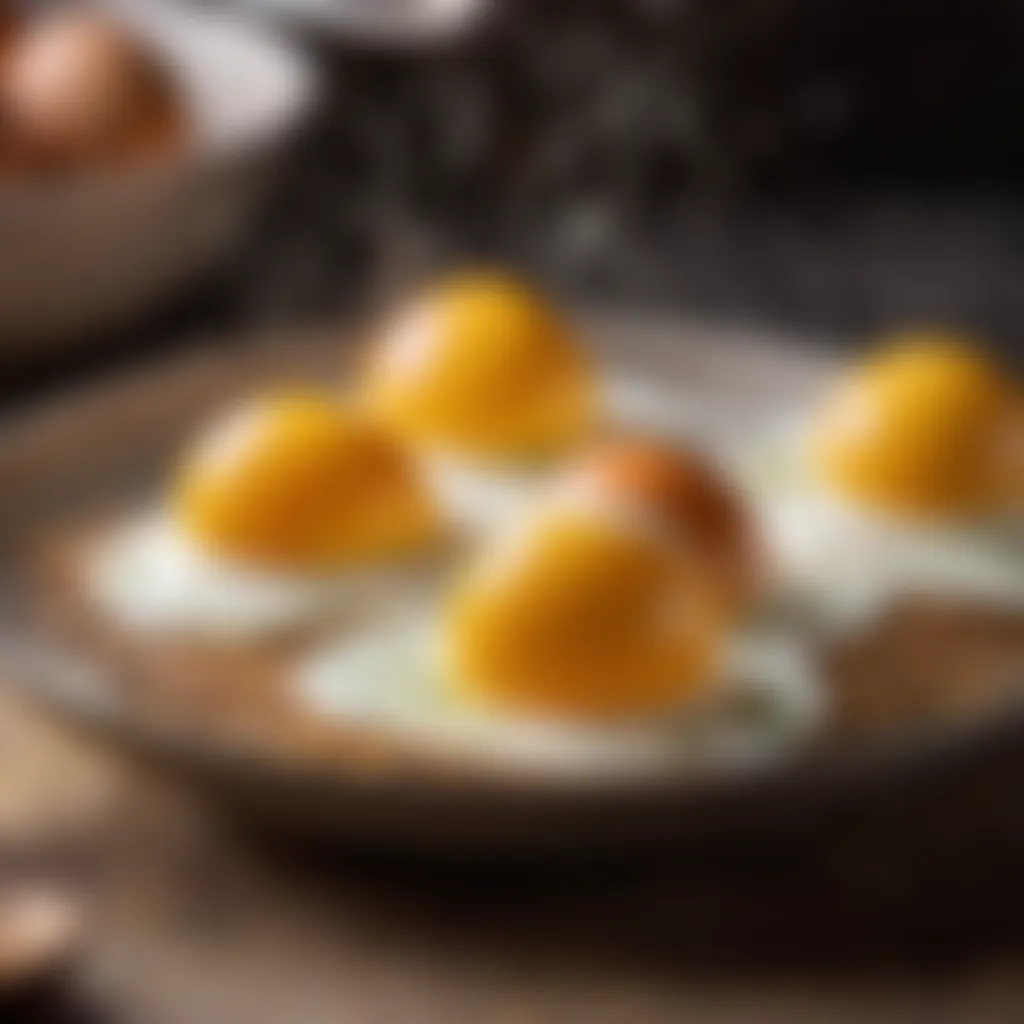

When combined correctly with your batter, the right leavening agent can give you a sky-high cake that’s a feast for both the eyes and the palate.
Baking Tools and Equipment
The foundation of any great vanilla cake lies not just in the ingredients, but also in the tools and equipment used during the baking process. Each utensil and piece of bakeware plays a pivotal role in determining the outcome. An unassuming wooden spoon or a simple mixing bowl can significantly affect texture and flavor. This section aims to shine a light on the importance of having the right tools, providing you with the ability to create consistently delightful cakes.
Required Baking Utensils
When it comes to baking, having the right utensils is essential. Here’s a list of must-have tools:
- Mixing Bowls: Opt for a set that includes various sizes. Stainless steel or glass bowls are preferable as they resist staining and are easy to clean.
- Measuring Cups and Spoons: Accurate measurements are critical. Invest in both dry and liquid measuring tools.
- Whisk: A sturdy whisk helps in incorporating air, vital for light and fluffy batter.
- Spatula: Silicone spatulas are great for scraping the sides of bowls and folding in ingredients without deflating the batter.
- Sifter: If you want a lump-free flour, using a sifter is a simple task that makes a big difference.
- Electric Mixer: A stand mixer or a hand mixer can save a lot of time and effort compared to manual mixing.
Selecting appropriate utensils not only streamlines the baking process but also enhances the final product’s quality.
Selecting the Right Bakeware
The bakeware you choose can impact the structure and doneness of your vanilla cake. Here are some considerations:
- Material Matters: Metal pans conduct heat well and are great for even baking. Glass or ceramic pans are excellent for browning but may require slight adjustments in baking time.
- Size of the Pans: Using pans that are too small or large for your recipe can lead to uneven baking. Always stick to the recipe’s recommendations.
- Non-Stick vs. Regular: Non-stick pans are convenient, but they can sometimes affect the cake's texture. A greased aluminum pan can provide a better crust.
- Round or Square: The shape of your cake can affect cook time and presentation. Round pans often bake more evenly than square ones.
Ensuring that you have appropriate bakeware tailored to your recipe enhances your chances of success. After all, a carefully crafted vanilla cake deserves a vessel that honors its potential.
Crafting the Batter
Crafting the batter is a pivotal stage in baking a vanilla cake, marking the transition from separate ingredients to a harmonious blend ready for the oven. A careful approach during this step ensures the cake isn't just an ordinary dessert but a delightful experience. Here’s why crafting the batter deserves attention, plus insights into mixing techniques, air incorporation, and temperature management.
Mixing Techniques
Achieving the perfect texture begins with the mixing techniques employed. This step requires attention to detail, as over-mixing or under-mixing the ingredients can drastically alter the final product. There are primarily two main mixing methods utilized in cake baking: the creaming method and the reverse creaming method.
- Creaming Method: This is the more traditional approach. You start by beating the butter and sugar together until pale and fluffy. The key here is to incorporate air, leading to a lighter cake.
- Reverse Creaming Method: Here, the flour and dry ingredients are combined with the butter before adding the liquids. This method produces a finer crumb and is popular for its ability to prevent excess gluten formation.
Whichever technique you choose, be mindful of your tools. A stand mixer usually does a better job than a hand mixer for the creaming method, as it produces consistent results with less effort.
Incorporating Air into the Batter
Air is the elusive ingredient that can make or break the fluffiness of a cake. When ingredients are mixed together, particularly when using the creaming technique, small pockets of air are created within the fatty components such as butter. To further maximize this effect, take the following into consideration:
- Butter Temperature: Room temperature butter mixes well, trapping more air. If it’s too cold, it won't cream properly, and too warm will lead to a greasy batter.
- Egg Incorporation: Adding eggs one at a time helps emulsify the batter and creates more volume. This step is crucial because if added too quickly, the batter may curdle.
“The secret to a cake that rises as it should lies in the incorporation of air, which contributes to texture and lightness.”
To achieve this, one can use high-speed mixing initially, which can be adjusted later as the dry ingredients are introduced. This step will ensure that the texture remains airy and light, leading to a tender cake.
Managing Temperature and Timing
Baking is as much a science as it is an art, with temperature and timing having considerable sway over the outcome. Here are a few guidelines to keep in mind:
- Ingredient Temperature: Always have your ingredients at room temperature before starting. Cold butter or eggs can result in a batter that doesn't emulsify well.
- Mixing Duration: While attention to detail is essential, the duration of mixing also matters. After incorporating the dry ingredients, mix just until incorporated to avoid developing gluten, which could result in a dense cake.
- Oven Preheat: Never underestimate the importance of a properly preheated oven. A cake batter requires an immediate burst of heat to rise correctly.
Being conscious of these factors not only enhances your baking skills but also produces consistently wonderful outcomes. Remember, each element is connected; managing one often influences another.
In summary, crafting the batter is a quintessential step in making your vanilla cake shine. By understanding the nuances of mixing, learning how to incorporate air, and carefully managing the baking environment, you're more likely to end up with a cake that stands out both in flavor and texture. This foundational knowledge lays the groundwork for an enjoyable and rewarding baking experience.
Baking the Cake
Baking the cake is, without a doubt, where the magic happens. This step transforms raw ingredients into a delightful vanilla cake, embodying not only the flavors but also the textures we’ve worked so diligently to assemble. Proper baking can make or break your cake, influencing its rise, crumb, and overall appeal. For those who have put in the effort to source quality ingredients and finely tune their batter, ensuring the baking process is correct can essentially serve as the cherry on top.
Optimal Baking Conditions
To set the stage for a successful bake, remember that preparation is key. The conditions within the oven significantly affect the cake's outcome. Here are some vital considerations:
- Temperature Accuracy: A preheated oven is crucial. If it’s not hot enough, your cake may not rise properly. Ideally, set your oven to around 350°F (175°C), helpin’ your cake achieve that golden brown hue.
- Placement in the Oven: Placing the pan in the center ensures even heat distribution. Avoid the corners, as they may bake unevenly, leading to an off-balance texture.
- Avoiding Distractions: Openin’ the oven too frequently can drastically change the temperature. Each time the oven door opens, you risk letting out precious warmth, which can ruin your cake's rise.
While these seem like common tips, sometimes it’s the basics that really count when you're wanting to get it right.
"A well-baked cake is a happy cake."
Understanding the dynamics of your oven can give you the upper hand. If your oven has hot spots—areas that tend to bake faster than others—by adjusting the pans slightly during the baking process, you can help level the playing field.
Signs of Proper Doneness
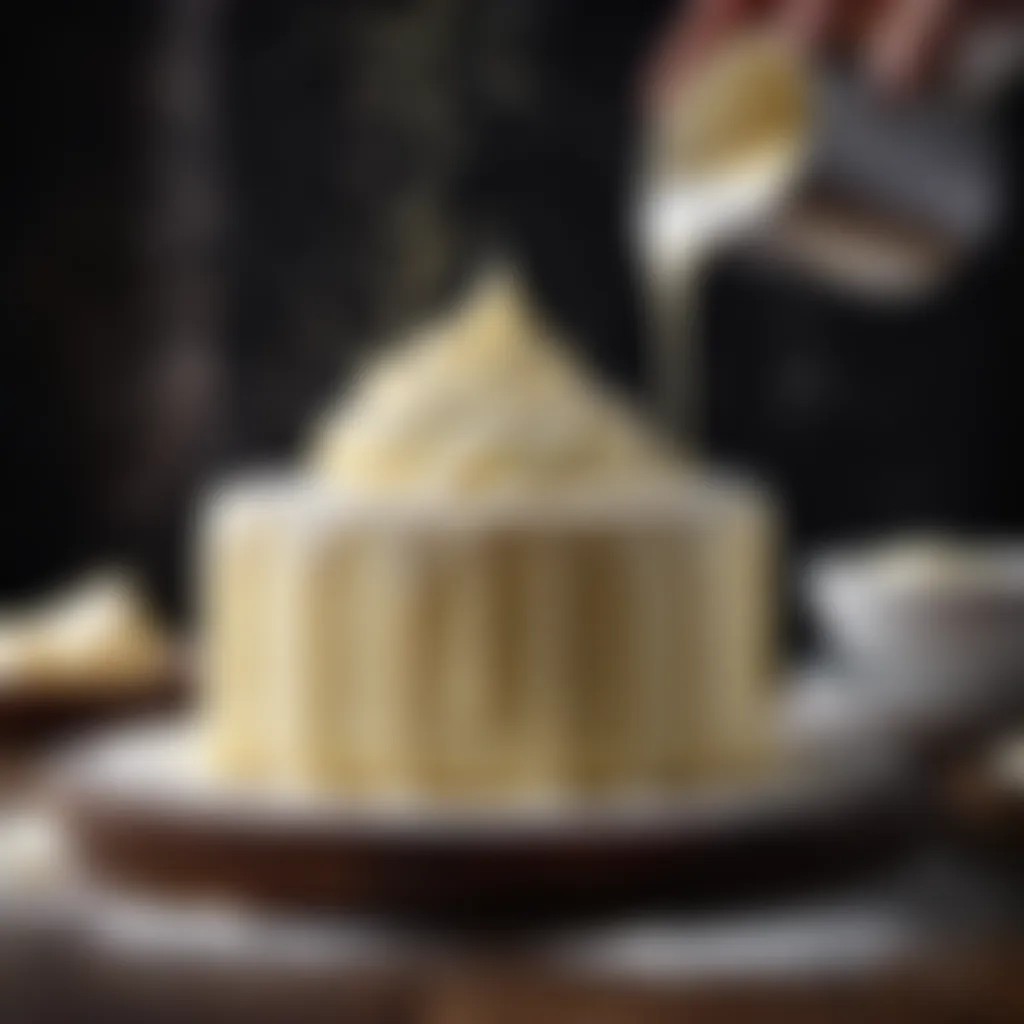

Knowing when your cake is adequately baked can be tricky. Here are the telltale signs:
- Golden Top: A lovely golden crust indicates that your vanilla cake is on the right track, suggestin’ a perfect bake.
- Spring Test: Gently press the top of the cake with your finger. If it springs back, that’s a good sign you’re ready to pull it from the oven. If it leaves a dent, give it a little longer.
- Toothpick Method: This classic method never fails. Insert a toothpick in the center of the cake; it should come out clean or with a few crumbs (but not wet batter).
- Sides Pulling Away: Another good indicator is when the edges pull slightly away from the pan, signifying that the outer layer is done while the inside finishes baking.
Keeping an eye on these signs, combined with a timer, will help prevent any surprises, such as an overbaked cake. It’s all about that sweet spot, just like finding a balance in baking your cake.
Cooling and Storing
Proper cooling and storing of your vanilla cake is crucial for maintaining its texture, flavor, and overall appeal. Neglecting this step can turn a flawless bake into something dry or unappetizing. One might wonder, why should anyone bother about cooling and storing? The answer lies in the simple fact that a well-cooled and correctly stored cake will not just taste better but will also retain its moistness and freshness longer. With the right techniques, your baking effort can be transformed into a delightful treat enjoyed across days.
Techniques for Cooling
Cooling a cake properly is not just a matter of leaving it to sit on the countertop. Here are a few key steps to ensure your cake cools effectively:
- Initial Cooling: Once the cake is out of the oven, it’s advisable to let it sit in the pan for about 10 to 15 minutes. This allows it to set slightly and reduces the risk of breaking when you transfer it.
- Rack Method: Carefully flip the cake onto a wire cooling rack. This step is vital as it allows air to circulate around the cake, preventing moisture from accumulating at the base. If you directly leave it in the pan, you may find a soggy bottom, which no one wants in their slice!
- Avoiding Quick Cooling: Resist the urge to place your cake in the refrigerator or freezer for a quick cooldown. This can create condensation, leading to a damp cake texture. Patience is key here; letting it cool gradually at room temperature is best.
"Allow your cake to dance with the cool air, not freeze in isolation."
Following these methods, you can enhance the cake's quality, allowing the flavors to stabilize, leading to a more enjoyable eating experience.
Storage Recommendations
Once your cake has cooled down completely, it's time to think about storage. The way you store a cake can significantly influence its taste and texture over time. Here are some tips to ensure your vanilla cake remains delicious:
- Wrap It Up: Use plastic wrap or wax paper to tightly wrap the cake. This helps in sealing in moisture and prevents the cake from absorbing any unwanted odors from the fridge.
- Airtight Holder: If you plan to store the cake for a longer period, consider placing it in an airtight container, which will not only keep the moisture in but also prevent it from drying out.
- Freezing for Future Enjoyment: If you find yourself with excess cake, freezing is an excellent option. Slice the cake before freezing; this way, you can take out only what you need. Wrap individual slices in plastic wrap followed by aluminum foil to prevent freezer burn. When ready to enjoy, simply thaw it at room temperature.
- Shelf Life: A well-stored vanilla cake can last about 3 to 5 days at room temperature and up to three months in the freezer.
By employing these techniques and recommendations, you ensure that your vanilla cake remains a delicious treat for more than just the day of baking. Each slice will still evoke that comforting blend of buttery, sweet vanilla goodness, making your baking efforts worthwhile.
Icing and Decorating
Icing and decorating are the cherry on top for any cake, including vanilla cake. They play a crucial role in presenting your creation as not just food, but a work of art. The visual appeal not only entices those who see it but also enhances the flavor and texture experience when enjoyed. Selecting the right icing can complement the cake's inherent flavors and add a delightful contrast that elevates each bite. Furthermore, how you decorate your cake can transform it from a simple dessert into a centerpiece worthy of any celebration. Thus, the choices and techniques here are significant; they bridge the gap between functionality and artistry.
Choosing the Right Icing
Selecting the right icing is akin to picking a frame for a beautiful picture; it should enhance what’s already there. For vanilla cake, buttercream, cream cheese frosting, and fondant are popular options, each offering unique flavors and textures.
- Buttercream is often the go-to choice. Its creamy richness melds beautifully with the delicate vanilla flavor. You can make it from scratch by whipping butter and powdered sugar together, adding a splash of vanilla extract and a bit of milk to reach the desired consistency.
- Cream cheese frosting, on the other hand, introduces a tangy quality that can balance the sweetness of the cake. It’s equally simple, combining cream cheese, butter, and sugar, but watch your measurements so you don’t end up with something too runny.
- Fondant provides a sleek, polished finish and makes for easier decoration, but it's more of an acquired taste. People either love or loathe its chewiness. It’s best used for more professional-looking presentations or themed cake designs.
Ultimately, the icing should not only look appealing but also align with your guests’ taste preferences. Consider their collective palate when deciding.
Techniques for Application
Now that you have chosen your icing, how do you apply it? First, make sure your cake layers are fully cooled; icing on a warm cake can melt and slide off, creating a mess rather than a masterpiece. Here are some methods to consider:
- Crumb Coating: This is the first layer of icing applied to trap crumbs. Apply a thin layer of your chosen icing over the entire cake with an offset spatula, then refrigerate it for about 30 minutes before adding the final layer.
- Using a Piping Bag: For more intricate designs, using a piping bag allows for greater control. You can create swirls, rosettes, or borders that add appeal without much effort. Just practice a little on parchment paper before going to the cake itself.
- Spreading for a Rustic Look: If you prefer a more homey, rustic touch, simply spread the icing with a spatula, letting some cake peek through. It gives a comforting vibe and makes your creation look homemade.
One thing to remember, especially when using buttercream, is to smooth it out with a bench scraper after you've applied it. This adds a clean, professional-grade finish without much hassle.
Garnishing for Presentation
Garnishing isn't just about aesthetics; it’s how you take something good and make it irresistible. Adding complementary elements can enhance both the look and taste of your vanilla cake. Here are a few clever ideas:
- Fresh Berries: Sprinkling assorted berries like strawberries, blueberries, and raspberries on top adds a burst of color and freshness. They also cut through the richness of the icing.
- Shaved Chocolate: A sprinkle of chocolate shavings provides a sophisticated drizzle of decadence. You can use milk chocolate for sweetness or dark for a more bittersweet touch.
- Edible Flowers: Pansies or nasturtiums can create an impressive focal point that’s also edible, taking your cake from simple to stunning.
- Nuts: Crushed almonds or hazelnuts can introduce a pleasing crunch and a nutty flavor that pairs wonderfully with vanilla.
Whatever garnishes you choose, make sure they complement rather than overshadow the vanilla flavor, as it's the star of the show. The final presentation should invite everyone to take a slice and enjoy a well-crafted vanilla cake!
In summary, icing, decorating, and garnishing your vanilla cake are integral to its success. These finishing touches should elevate the cake both visually and taste-wise, making every bite a memorable experience.
Variations of Vanilla Cake
Exploring variations when it comes to vanilla cake is vital for any baker. It opens up a world of possibilities and creativity in baking. A cake isn’t just flour, sugar, butter, and eggs; it can be a canvas for flavors that tell your personal story or honor a special occasion.
Incorporating Flavors
Adding flavors to your vanilla cake can elevate the taste to a whole new level. Think about complementing that vanilla base. For instance, a hint of almond extract can add a nutty profile without overwhelming the classic taste. Generally, if you feel a bit adventurous, try folding in citrus zest—lemon or orange can make a delightful twist, balancing sweetness with a touch of acidity.
When incorporating flavors, consider the ratios carefully. Too much of an added flavoring can easily obfuscate the main vanilla notes. Start with small amounts, perhaps a teaspoon, and taste as you go. This way, you can control the infusion without steering too far from the classic essence. Remember:
- Citrus Zest: 1 teaspoon can go a long way.
- Nut Extracts: Use sparingly, a quarter teaspoon can work wonders.
- Spices: Think cinnamon or ginger for warmth.
Using Different Fillings
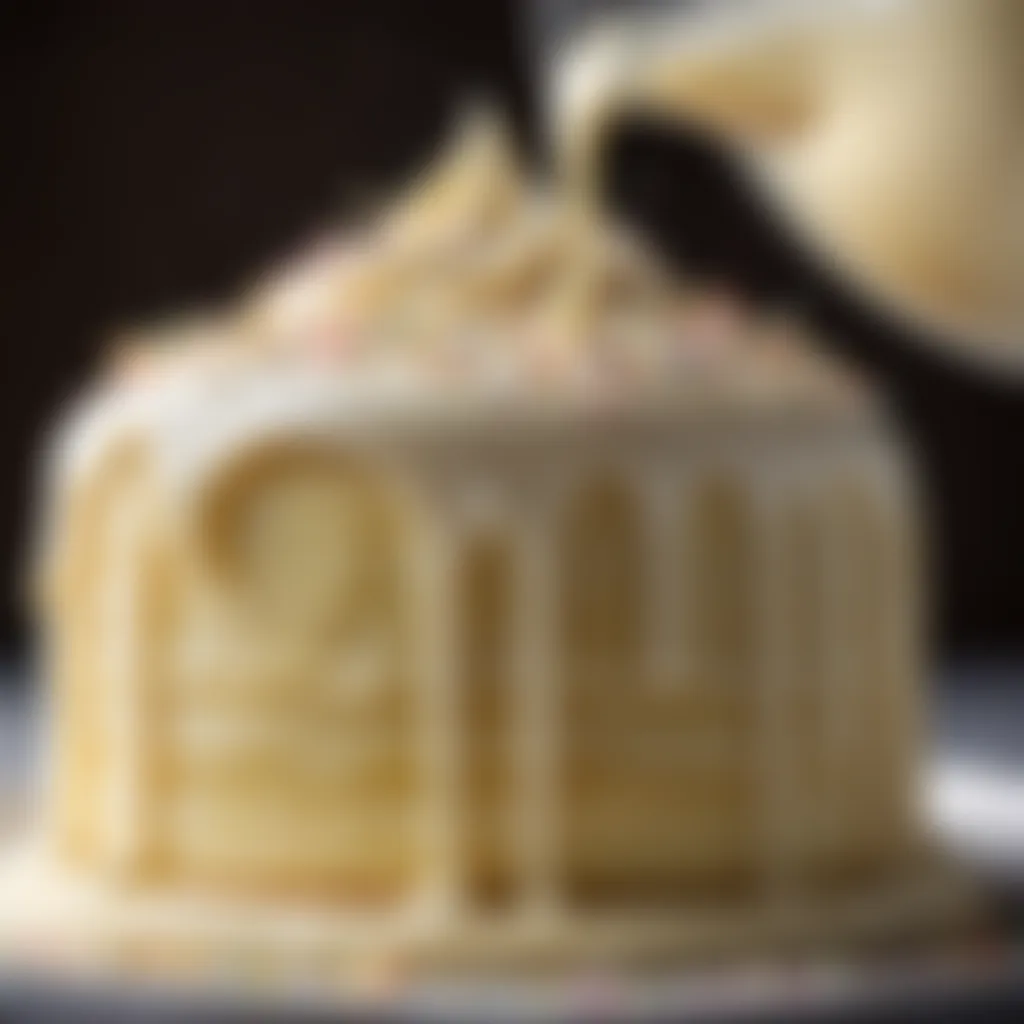
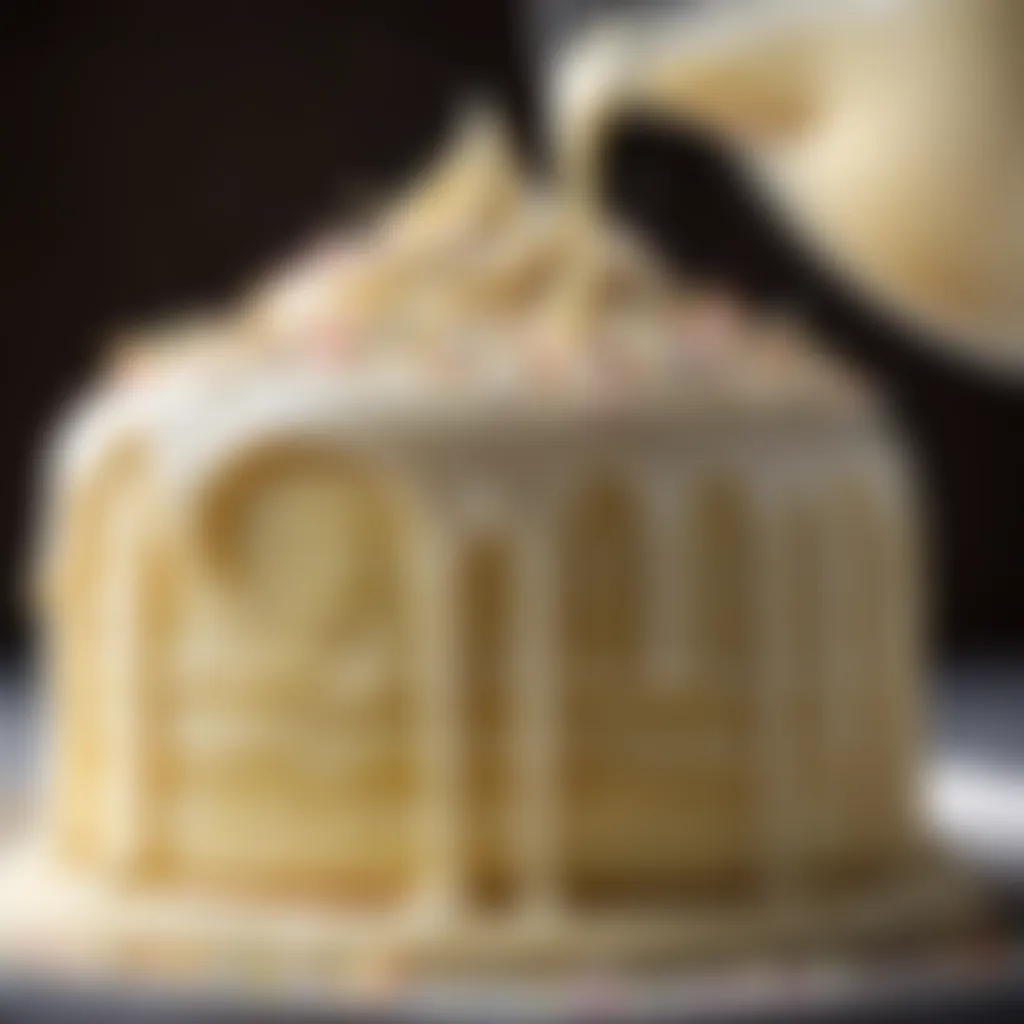
Fillings can transform a basic vanilla cake into something extraordinary. Creamy custards or fruit compotes can be delightful surprises in every slice. For example, a rich vanilla pastry cream can complement the cake's texture while adding depth in flavor.
Fruit fillings, like raspberry or strawberry, contribute a fresh tartness, providing a contrast to the sweetness of the cake. Furthermore, consider a chocolate ganache for those who enjoy a richer experience.
When using fillings, keep certain aspects in mind:
- Temperature of Fillings: Ensure that fillings are cooled and not too runny; a cold filling can also help stabilize the layers.
- Layering Strategy: Spread the filling evenly, ensuring that it doesn’t ooze out when the cake is assembled.
- Pairing Flavors: Always think how your filling will mesh with the vanilla base. A fruity filling with vanilla cake can be delightful.
Options for Gluten-Free Baking
Gluten-free options are increasingly important in today's world, catering to dietary needs without compromising flavor. For a gluten-free vanilla cake, the key is to select the right flour alternatives. Almond flour offers a rich flavor, while coconut flour can provide moisture.
A mix of gluten-free materials often yields the best results. For instance, blending brown rice flour with a bit of tapioca flour can mimic the texture of regular flour effectively. Additionally, adding xanthan gum may help bind the batter. Here’s a quick tip:
- Use 1 cup of gluten-free flour blend in place of regular flour, and add 1/4 tsp of xanthan gum to help with the structure.
As you journey into gluten-free baking, check for cross-contamination as many flours are processed in facilities that handle wheat. By taking care of these details, you can produce a cake that not only fits dietary preferences but tantalizes the taste buds.
"Baking is a science. Precision counts, but so does the heart you put into it."
In summary, variations of vanilla cake offer endless possibilities. From playing with flavors and fillings to accommodating gluten-free needs, this cake can easily become a personalized masterpiece in your home kitchen.
Common Mistakes to Avoid
Baking a vanilla cake might seem like a straightforward task, yet there are hidden pitfalls that can sabotage even the best efforts. A well-executed cake relies on precise measures and processes, even down to the tiniest details. Understanding what can go wrong not only enhances your baking mastery but also transforms your cake into something delightful and memorable. Let’s explore some common mistakes that home bakers should be aware of.
Understanding Measurement Errors
When it comes to baking, accuracy in measurement is king. A little miscalculation can throw off the entire balance of your ingredients. For instance, if you scoop flour directly out of the bag, you might be packing it too densely, resulting in a dry or overly crumbly cake. Instead, use the spoon and level method: spoon the flour into your measuring cup and then level it off with a knife.
When measuring liquids, ensure you use a liquid measuring cup with clear markings at eye level. A common mistake is relying solely on volume. Disregarding weight in favor of volume can lead to inconsistent results, especially with dry ingredients.
"Baking is science and art; precision in measurement is the brush stroke that paints flavor and texture."
Neglecting Oven Calibration
An often overlooked aspect of baking is the temperature of the oven. Many bakers set their ovens to the desired temperature without considering accuracy. Ovens can sometimes run hotter or cooler than the dial suggests, leading to unexpected results. A quick solution? An oven thermometer can save the day. Place one inside your oven and check the reading before you bake.
If your oven is consistently off, you might end up with a vanilla cake that is either burnt on the outside and raw on the inside or overly dry. Baking is about rhythm—getting the temperature just right ensures that the cake rises and bakes evenly, giving you that soft and tender texture all seek for.
Overmixing Concerns
When crafting the batter for your vanilla cake, it's vital to strike that perfect balance. Overmixing can develop gluten in the flour, leading to a dense and chewy cake instead of the light, fluffy treat you want. Once you begin adding the dry ingredients to the wet ones, stir just until combined.
To avoid this pitfall, consider mixing by hand with a rubber spatula or a wooden spoon. This allows you to fold the ingredients together gently and helps preserve the air you incorporated earlier. Remember, it’s okay if there are a few lumps; they’ll bake out, but the air bubbles won’t return if you overdo it.
In summary, be it measuring, checking the oven temperature, or gently mixing your batter, keeping these common mistakes at bay will lead you toward baking triumph. Watch for these details, and your vanilla cake is bound to impress at any gathering.
Epilogue and Final Thoughts
Baking a vanilla cake is more than just following a list of instructions; it’s about the experience, the learning, and the pleasures that come with it. This section wraps up the journey through the creation of a vanilla cake, highlighting why every part of the process matters. The significance of this concluding part not only resides in summarizing what the reader has learned, but it invites bakers of all levels to appreciate the nuances that contribute to a perfect cake.
Evaluating the methods and decisions made throughout the baking process can enhance one’s skills. Why certain ingredients were chosen, how they were mixed, and the baking conditions encountered all play pivotal roles in the final product. Reflections allow one to make adjustments in future endeavors. For example, if the cake didn’t rise as expected, a simple recalibration of oven temperature or understanding the flour's properties can lead to better results next time. This awareness simplifies the journey from novice baker to a more seasoned one, shaping a deeper connection with the craft of baking.
Baking is also an art that thrives on experimentation. By understanding the techniques discussed throughout this article, bakers can feel empowered to take risks, whether that means swapping out vanilla for almond extract, introducing spices like cinnamon, or even creating a zesty lemon version on a whim. This first-hand trial and error elevates a baker's confidence.
"Baking isn't just about following tradition; it's about making it your own, one batch at a time."
Moreover, the benefits of baking extend beyond just the delicious results. There’s something cathartic in the act. The rhythm of measuring, mixing, and watching ingredients transform into something delightful offers a reprieve from the busy world outside. Each step is an opportunity to immerse oneself in the moment, fostering patience and mindfulness. For many, this serves as a form of stress relief.
Ultimately, the joy derived from serving a freshly baked vanilla cake to family or friends, or simply indulging in a slice oneself, rounds out the experience. Bask in the satisfaction of not only creating a beautiful dessert but one that resonates with personal culinary touches. The journey may have its ups and downs, but the end result—a delicious vanilla cake—makes every moment worth it.
Reflecting on the Process
Taking a moment to reflect on the entire baking process holds fantastic importance. It's a snapshot of the strengths, challenges, and discoveries experienced at each stage. After mastering the techniques, kick back and think about how each decision stood up to the test, essentially leading to tasty success.
- Ingredient Choices: Did you choose organic vanilla? What was the outcome?
- Mixing Method: Was your batter perfectly blended, or were there lumps?
Creating space for reflection not only improves future baking paths but cultivates a sense of ownership over the craft. Each successful cake fuels the desire to try something new, improving techniques and understanding.
The Joy of Baking
Baking is a delightful journey filled with galore moments of joy and satisfaction. The aroma wafting through the kitchen, the thrill of anticipation while the cake is baking, and finally revealing the masterpiece are steps that build a wonderful experience.
Moreover, baking can forge bonds with others. Whether it's gathering family to stir the batter or surprising a friend with a homemade cake, these actions create shared memories. They transform simple ingredients into tokens of affection, further enhancing the experience.
It's about the smiles exchanged and those satisfied sighs after a bite of cake. Found not just in the taste, but in the stories that are woven through each layer of the vanilla cake, baking opens doorways to creativity and emotional connections that transcend mere desserts.
By embracing baking, you embrace the chance to spread joy, nurture connections, and indulge in a unique craft—one that is rewarding in every sense of the word. So, preheat that oven, gather your ingredients, and savor the joyful process of baking.







